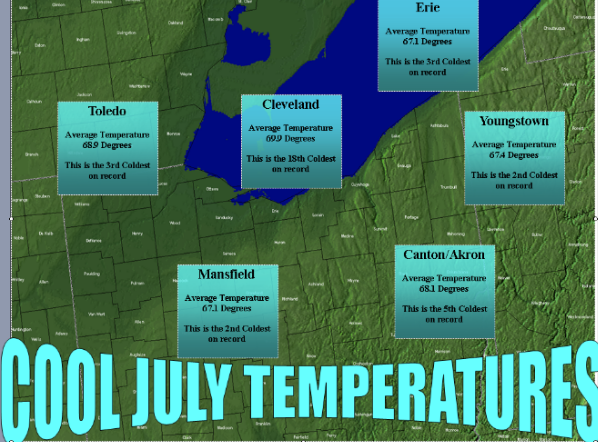Cool July
Where's the Summer Heat?

July was significantly cooler than normal across the region. It ranked in the top 10 coldest July's on record at most of the climate stations in northern Ohio and northwest Pennsylvania. The weather patter in July was more reminiscent of January with a northwest flow persisting for most of the month. The jet stream, or the river of air some 20 to 30 thousand feet above us, was from the northwest. This northwest flow pulled in frequent cool air masses from Canada. Each reinforcing cool air mass was ushered in by a cold front which also brought regular rounds of showers. In a typical July, the jet stream is often from the southwest and brings in very warm air masses. This July was also unusual in the absence of any hot air. Most areas topped out with a maximum temperature for the month only in the mid 80s. It is unusual not to reach the 90s in July. A persistent weather pattern is not that unusual though. It is common for the jet stream to get "locked into" a flow pattern based on global weather systems. Eventually the pattern will shift and we will find ourselves in a more seasonable pattern or perhaps a warmer than normal pattern.
| Toledo | Mansfield | Cleveland | Akron-Canton | Youngstown | Erie, PA | |
|---|---|---|---|---|---|---|
| Average Temperature for July |
68.9
|
67.1
|
69.9
|
68.1
|
67.4
|
67.1
|
| Ranking in Records |
3rd
|
2nd
|
18th
|
5th
|
2nd
|
3rd
|
| Warmest Temperature July 2009 |
87
|
84
|
86
|
85
|
86
|
84
|
|
|
|
Image Credit: Department of Atmospheric Sciences at the University of Illinois Urbana-Champaign, WW2010
|
|
NWS Cleveland Climate page: https://www.weather.gov/climate/index.php?wfo=cle All of these monthly statistics for our climate stations can be found year round by going to the following link and selecting your station. Data each month are updated within a week if data for the previous month made the "top ten." NWS Cleveland Unique Local Climate Data Records date back to 1874 for Erie |